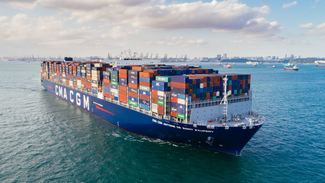London, UK – According to a new study, at least $1 trillion of capital investment in land-based and ship-related infrastructure will be required to halve international shipping’s greenhouse gas emissions by 2050.
A new study by UMAS and the Energy Transitions Commission for the Getting to Zero Coalition spells out the scale of the challenge. Depending on the production method, the cumulative investment needed between 2030 and 2050 to halve shipping’s emissions amounts to approximately $1-1.4 trillion, or an average of $50-70 billion annually for 20 years. If shipping is to fully decarbonize by 2050, this will require further investments of some $400 billion over 20 years, bringing the total to $1.4-1.9 trillion
“We need to understand the scale of the challenge to solve it,” says Johannah Christensen, Managing Director, Head of Projects & Programmes at the Global Maritime Forum, a partner of the Getting to Zero Coalition. “Shipping’s shift to zero carbon energy sources calls for significant infrastructure investments. The investment needed should be seen in the context of global investments in energy, which in 2018 amounted to $1.85 trillion. This illustrates that shipping’s green transition is considerable, but certainly within reach if the right policy measures are put in place.”
“Energy infrastructure and ships are long-life capital-intensive assets that normally evolve slowly. In the next 3 decades however, our analysis suggests we will see a disruptive and rapid change to align to a new zero carbon system, with fossil fuel aligned assets becoming obsolete or needing significant modification. Even though regulatory drivers of this system change such as carbon pricing are only starting to be debated, the economic viability of today’s investments and even the returns on recent investments will be challenged, and the sooner this is factored in to strategies and plans, the better,” says Dr Tristan Smith, Reader at the UCL Energy Institute.
The analysis also sheds light on where investments need to take place. These can be broken down into two main areas: ship-related investments and land-based investments.
The biggest share of investments is needed in the land-based infrastructure and production facilities for low carbon fuels, which make up around 87% of the total. This includes investments in the production of low carbon fuels, and the land-based storage and bunkering infrastructure needed for their supply.
Only 13% of the investments needed are related to the ships themselves. These investments include the machinery and onboard storage required for a ship to run on low carbon fuels in newbuilds and, in some cases, for retrofits. Ship-related investments also include investments in improving energy efficiency, which are estimated to grow due to the higher cost of low carbon fuels compared to traditional marine fuels.
“Sustainable investing is here to stay. We foresee that there will be a great appetite for investments in sustainable infrastructure projects that help reduce greenhouse gas emissions,” says Michael Parker, Chairman of Global Shipping Logistics & Offshore at Citi.
“Much of shipping’s decarbonization will take place on land. It is a systemic transformation that goes beyond the capabilities of the maritime industry alone. We need to bring together the full range of upstream and downstream fuels value chains to unlock shipping’s shift to zero carbon energy sources. Done right, this represents a trillion-dollar market opportunity,” says Lord Adair Turner, Chair of the Energy Transitions Commission. (photo CMA CGM)





